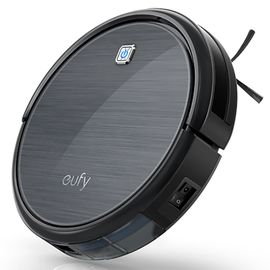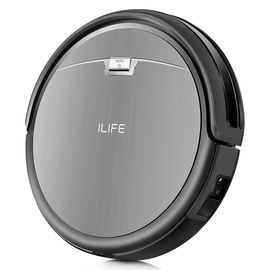Best Robot Vacuums Under $300
A robotic vacuum won't replace a canister or upright vacuum for serious cleaning — even the best robot vacuum can't clean stairs, furniture, or long-pile carpeting — but it can keep the daily dirt and dust at bay. Robotic vacuums are convenient for people who don't like to vacuum that often and great for cleaning beneath furniture where traditional vacuums can't reach. Some highly rated robot vacuum cleaners carry price tags of more than $600, but we found several models that perform nearly as well for less than half the price.
Our Top Pick


iRobot Roomba 690 Review
Best Smart Robot Vacuum Under $300
Pros:
- Connects to Amazon Alexa and Google Home.
- Cleans carpets and hard floors equally well, according to experts and users.
- Dual central brush and rotating side brush for edges.
- Special dirt sensor.
- Height automatically adjusts for different floor surfaces.
- Comes with a virtual wall barrier.
- Parts are easy to maintain and replace; washable filter.
Cons:
- Price is on the high side.
- At 3.7 inches, this model requires about 4 inches of clearance under cabinets and furniture, users say (Roombas tend to be fairly heavy and thick).
- Sometimes gets hung up on cords and cables.
- Occasionally fails to return to its charging station.
- Relatively short run time of 60-75 minutes.
Takeaway: The least expensive model in the iRobot Roomba line, the Roomba 690 comes in at the very top of our Cheapism price limit. But consumers looking for an efficient and comparatively advanced robot vacuum that earns enthusiastic endorsement from both pros and owners might find it worth the extra outlay. Wi-Fi-enabled for convenient smartphone or voice control, the 690 allows for easy cleaning scheduling and also lets users monitor cleaning activity and view cleaning history through the app. Most reviewers say this vacuum is powerful enough to pick up pet hair and other debris, and the dust cup is easy to empty. They also like the Dirt Detect feature, which can sense heavily soiled areas and adjust to compensate. Many owners wish it had the same room-mapping sensors of more expensive iRobot models to clean floors more quickly.

Eufy RoboVac 11 Review
Best Robot Vacuum Under $300 Without Wi-Fi
Pros:
- Performed well on both carpeting and hardwood floors in expert tests.
- Relatively quiet, users say.
- 3 cleaning modes.
- 3-stage filtration.
- Remote control; can be programmed to run on a daily schedule.
- Roller brush and 2 side brushes.
- Runs for up to 90 minutes on a full charge; can be charged on base or via adapter.
- Very low profile (3.1 inches); easily navigates under furniture.
Cons:
- Manufacturer does not offer replacement batteries or parts (filters and brushes can be purchased via third-party sellers).
- Prone to getting stuck on floor vents and other obstacles, owners report; lots of random shutdowns when tested.
- Pet hair and threads easily tangle in the central brush; not recommended for high-pile rugs.
Takeaway: The Eufy RoboVac 11 is a top seller on Amazon, and reviews from both experts and users are generally very positive. Most owners say this robot vacuum is very thorough and good at passing over thresholds or floor edges, a frequent issue with many cheaper models. It can also run for 90 minutes on a full charge — longer than many other robotic vacuums — and hold more dirt than a lot of the competition with its 0.6-liter dust cup. On the downside, the Eufy 11 occasionally appears to meander randomly or stops running for no apparent reason, and a number of reviewers say their vacuums began malfunctioning after several weeks of use. Nevertheless, even with these drawbacks, this robot vacuum is considered one of the best available on a budget.

Bobsweep Bobi Pet Review
Best Robot Vacuum for Pets Under $300
Pros:
- Sweeps, vacuums, and mops.
- HEPA filter and UV sanitizer.
- Bristle and rubber brushes beneath, as well as a side brush.
- Electronic touch controls and a wireless remote.
- 3 cleaning modes (including "juice" charging mode) and programmable cleaning schedule.
- Comes with a block accessory to set digital barriers.
- 90-minute run time is competitive for the category.
- Experts and users say it's fairly quiet compared to other robot vacuums.
- 2-year warranty bests other brands.
Cons:
- Attachable microfiber mopping pads must be manually dampened.
- Has trouble avoiding obstacles and pushes lightweight furniture around.
- Gets stuck when transitioning from hard floors to carpet, users say.
- Some owners report that it has difficulty finding its charging station.
- Hair tends to build up on the main roller brush, requiring frequent cleaning.
- At 3.5 inches high, it's not as thin as some other models.
Takeaway: Pet owners know that a good vacuum is essential for keeping fur and dander under control. Unfortunately, most pet-focused robot vacuums fail to live up to their promise. This affordable, yet fairly feature-rich Bobi by Bobsweep gets the best endorsements of the bunch for picking up pet hair. While expert reviewers insist that its performance otherwise is just average compared with some (usually pricier) competitors, users are generally satisfied with the cleaning power for the price. They like using the included remote control to program the vacuum, and the HEPA filter is a big selling point. A sore spot, however, is the Bobi Pet's tendency to get stuck. Some owners complain that it can sometimes wander and get caught looping endlessly around one room, and it's known for being downright pushy when it comes to obstacles — we read numerous reports of this robot vacuum moving chairs and potted plants clear across the floor.

Ecovacs DeeBot N79S Review
Good Smart Robot Vacuum Under $300
Pros:
- Very inexpensive for a Wi-Fi-enabled robot vac.
- Owners say the app is very easy to use; a standard remote is also included.
- 4 cleaning settings with time scheduling.
- 3-stage filtration.
- Central rolling brush and 2 side brushes.
- Lasts about 102 minutes on a full charge, significantly longer than many other models.
Cons:
- Users say the roller brush needs to be cleaned often.
- Not compatible with all smart-home devices.
- Some complaints of the vacuum getting stuck frequently and failing to find charging dock.
Takeaway: Overall, reviewers say this smart robotic vacuum from Ecovacs does a good job of cleaning carpet (at least thinner carpets) and bare floors, but there are some aspects of its performance that hold it back. We read a number of complaints from owners who say that despite its extra-powered "max mode" and spot-cleaning setting, this vacuum is still prone to missing dirty spots on the floor and sometimes leaving trails of dust behind. At 3.3 inches, it's not especially slim, making it more prone to get caught on the lip of a low-lying couch or cabinet. That said, its biggest boon is that it's one of the least expensive Wi-Fi-enabled robot vacuums around, and consumers looking for a vacuum that will complement a smart-home setup love that this inexpensive Deebot can be app-controlled from their phones or using Amazon's Alexa digital assistant. It isn't compatible with other devices like Google Home, however, a major disappointment for some users.

iLife A4s Review
Good Robot Vacuum Under $200
Pros:
- Relatively low, 3-inch profile; can reach tight spots other vacs can't.
- Experts say it cleans hard floors and low carpeting equally well.
- 5 cleaning modes, including edge clean, spot clean, max clean, and small-room.
- Remote for scheduling cleaning and manually directing the vacuum if desired.
- Central brush beneath; dual rotating side sweepers.
- 3-stage filtration.
- Incredibly long run time of 120 to 140 minutes.
Cons:
- Cleans relatively slowly.
- Navigation is not necessarily a strong suit; sometimes has difficulty finding its charging base.
- Scattered complaints about durability.
Takeaway: This compact iLife robot vacuum is a good cheap option that performs nearly as well as more expensive models. Owners say the remote control, which is the only means of programming the vacuum, is fairly easy to use. Experts say the vacuum is relatively quiet and does a surprisingly good job of sucking up dirt, debris, and even pet hair (thanks to the roller brush beneath). This model randomly meanders around a room unless purposefully steered, and we also found a few complaints of the vacuum getting stuck on heavy carpeting. But all in all, users and professional reviewers are pretty bullish on the iLife A4s — it even earns a 4-star "excellent" rating from electronics aficionados at PCMag. For less than $200, it's a good pick for consumers not necessarily committed to the robot vacuum craze and willing to sacrifice bells, whistles, and better navigation capabilities for a true bargain buy.

Pyle Pure Clean PUCRC25 Review
Good Robot Vacuum Under $100
Pros:
- One of the cheapest robot vacuums around.
- 1-touch operation makes it a cinch to use.
- Very low profile, at just 2.9 inches.
- Washable HEPA filter helps trap dust and allergens.
- 2 detachable side brushes.
Cons:
- 55-minute run time is significantly shorter than the other vacuums on our list.
- No docking base; must be plugged in for charging.
- Users say it doesn't transition between surfaces well.
Takeaway: This Pyle Pure Clean robot vacuum is incredibly cheap, at less than $100, and does a decent job sweeping up debris, including pet hair. It's simple to operate, with a washable filter and top-empty dustbin that make keeping it clean an easy task, and users say it excels on flat surfaces and hardwood floors — just don't expect it to work as well on rugs, especially since there's no center brush. Lacking some of the fancier features found on more expensive models, like a docking station or programmable cleaning schedules and modes, the Pure Clean PUCRC25 doesn't appear at the top of consumer product experts' recommendation lists. But many industry reviewers and owners with tempered expectations insist that this slim robovac is a nicely priced, bare-bones model for consumers who just want a little help keeping smooth surfaces and small areas dirt-free without dragging out a full-size vacuum every day. There's a newer model, the PUCRC26B, that garners lots of positive user reviews and adds rotating side sweepers to the mix (buy it on Amazon), but we're not sure that it's worth the extra $20.


















